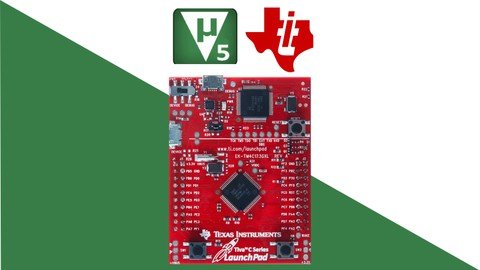
Published 6/2022
MP4 | Video: h264, 1280×720 | Audio: AAC, 44.1 KHz
Language: English | Size: 7.85 GB | Duration: 15h 5m
Using Keil uVision IDE for understanding and developing all the peripheral drivers for TM4C123 (Arm Cortex M Processor)
What you’ll learn
Programming TM4C123GH6PM microcontroller in Keil uVision IDE
You will learn how to program a TM4C123 Microcontroller from scratch with datasheet approach
Build your own projects with the TM4C123 microcontroller.
You will be learning all the peripherals programming from scratch no libraries used in Keil uVision IDE
The class starts from the basics of setting up a microcontroller programming and hardware environment.
Writing peripheral driver for TM4C123GH6PM microcontroller
Arm Cortex M Processor Understanding
Requirements
Basic knowledge on electronics components
Basic knowledge on C programming
Basic circuit building skills from schematics
Description
Over a 45+ lecture videos, 15+ Hours of Full HD Content that will take you in an interactive learning to not only master the coding of TM4C123 Microcontroller and also Arm Cortex M processor, And it will make you familiar and capable for writing drivers and building applications as per your requirement with similar controllers with same processor, but also learn the very basics of TM4C123GH6PM Microcontroller internal structure and hardware schematics along with basics of TM4C123GH6PM for writing peripheral drivers required for building your own products out of STM32 microcontroller, how it really works, it’s parts and how your code is working inside the CPU of a Microcontroller. Hi, welcome you all to this course on Bare Metal Programming in Arm Cortex-M Processor (TM4C123).The course is structured for the need of learners to understand microcontrollers from scratch till you master your skills. This course is the outcome of the experience I gained after training many of graduate students and working professionals in person, and with my expertise in the field of embedded systems. Few basic Embedded C concepts are also covered.SM Training Academy invites you all to enroll in this course and explore the world of embedded systems with step by step guidance by own expert trainers to excel in their career. There is no better way to master and understand the PIC microcontroller than joining this course. Whatever you want to learn is available in this course and also we will be updating the course with new lectures in a periodical manner. So join the course and enjoy learning.
Overview
Section 1: Introduction
Lecture 1 Introduction to the Course
Section 2: Understanding Architecture of Arm Processor
Lecture 2 RISC Architecture Explained
Lecture 3 Fundamentals of ARM Architecture
Lecture 4 ARM buses and its types
Section 3: Understanding Arm Cortex-M Processor
Lecture 5 Introduction to Arm Cortex-M Processor
Lecture 6 Arm Cortex-M Architecture Explained
Section 4: Hardware and software used in this Course
Lecture 7 Hardware and software used in this Course
Lecture 8 Installing the necessary softwares along with drivers required
Section 5: How CPU Works ?
Lecture 9 How CPU Works ..? (Arm Cortex M)
Lecture 10 Little and Big Endian Concept
Section 6: Implementation of C Programming in Arm Cortex M
Lecture 11 Pointers in C Explained
Lecture 12 Blinking LED in Tiva C launchpad using raw addresses and pointers
Lecture 13 Preprocessor’s in C with Tiva C microcontroller Addresses
Lecture 14 Using Texas Instrument Header File in Keil IDE
Lecture 15 Bitwise Operators in C
Lecture 16 Using Bitwise Operators in Embedded Processors
Lecture 17 Creating Source Files in Keil uVision IDE
Section 7: Structures in C
Lecture 18 Introduction to Structures in C
Section 8: CMSIS in Arm Processors
Lecture 19 What is CMSIS..?
Lecture 20 Understanding and Creating CMSIS for LED Bilink in Tiva C Microcontroller
Lecture 21 Using CMSIS from Silicon Vendor ->Texas Instrument
Section 9: Interfacing LED with TM4C123
Lecture 22 Interfacing LED with TM4C123
Section 10: Interfacing Push Buttons with TM4C123
Lecture 23 Input Devices Working Explained
Lecture 24 Interfacing Push Buttons with TM4C123
Section 11: Systick TImer in TM4C123
Lecture 25 Systick Timers in Arm Cortex M
Lecture 26 Systick Timers in TM4C123
Lecture 27 Creating millisecond delays in program using Systick Timer
Section 12: Interfacing 7Segment display with TM4C123
Lecture 28 7 Segment Display Working Explained
Lecture 29 Interfacing 7Segment display with TM4C123
Section 13: Interfacing LCD with TM4C123
Lecture 30 16×2 LCD Working Explained in 8 Bit Mode
Lecture 31 Interfacing 16×2 LCD with TM4C123 in 8 Bit Mode
Lecture 32 16×2 LCD Working Explained in 4 Bit Mode
Lecture 33 Interfacing 16×2 LCD with TM4C123 in 4 Bit Mode
Section 14: Interfacing Keypad with TM4C123
Lecture 34 Keypad Working Principle Explained
Lecture 35 Interfacing 4×3 Keypad with TM4C123
Section 15: External Interrupt in TM4C123
Lecture 36 Interrupt Working Explained in Microcontroller’s
Lecture 37 Implementing External Interrupt in TM4C123
Section 16: Timers in TM4C123
Lecture 38 Timers in TM4C123
Lecture 39 Implementing Timer Interrupt for Accurate delays in TM4C123
Section 17: PWM in TM4C123
Lecture 40 PWM Working Principle Explained
Lecture 41 Generating PWM pulses of required frequency and dutycycle in TM4C123
Section 18: ADC in TM4C123
Lecture 42 ADC Module Working Principle Explained
Lecture 43 Interfacing Variable Resistor with TM4C123
Section 19: UART Serial Communication in TM4C123
Lecture 44 UART Serial Communication Working Principle Explained
Lecture 45 UART Data Transmission in TM4C123
Lecture 46 UART Data Reception in TM4C123
Anyone with a curiosity for making electronics,People with some experience in electronics,People with an beginner knowledge of embedded systems
Password/解压密码www.tbtos.com
转载请注明:0daytown » Bare Metal Programming In Arm Cortex-M Processor (Tm4C123)